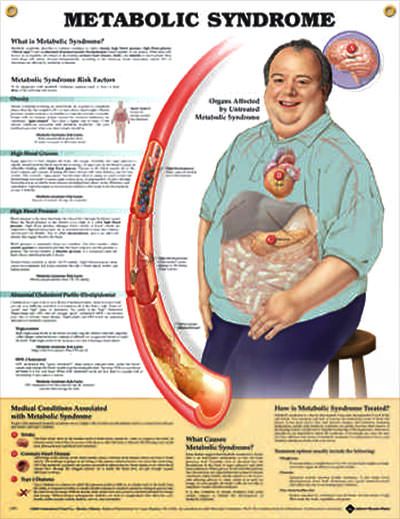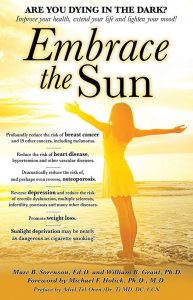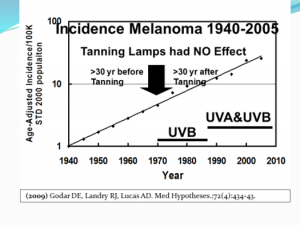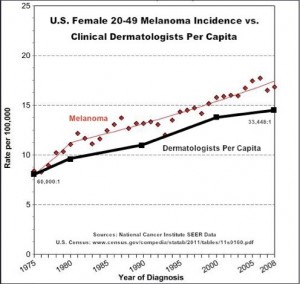Vitamin B3, other lifestyle factors and skin cancer, by Marc Sorenson, EdD
Vitamin B3 is not a topic I expected to find while checking out the latest on nutrition and skin cancer. Consequently, it surprised me that research showed an impressive effect of vitamin B3 on protection against non-melanoma skin cancers (NMSC). NMSC are also known as squamous and basal cell carcinomas (SCC and BCC). The protection occurs against UV (ultraviolet) light, which researchers claim is the prime factor causing squamous and basal cell cancers. In the aforementioned study, treatment with vitamin B3, 24 hours before exposure of skin to UV, reduced oxidative stress significantly. It also had the ability to repair DNA damage. This is another study demonstrating that sunlight is not the enemy. Rather, NMSC is due to a combination of factors, including environmental toxins, poor habits of hygiene, smoking, and poor nutrition.
When the skin lacks protection, which is too often the case, then excessive sun exposure can cause damage and pain.
However, that is not what happens in a well-adjusted and well-cared-for life. Protection, whether by vitamin B3 or other additional healthful factors, can stop the damage. This may render sun exposure one of God’s greatest gifts to human health and wellbeing. Sun exposure is really only a minor factor in NMSC.
Here are factors beyond sunlight (and vitamin B3) that make a difference in this skin cancer:
Smoking predicts a higher risk of squamous cell carcinoma (SCC). After adjustment for sun exposure, age and sex, smoking predicts a doubling of the risk for SCC. In addition, there is a dose/response relationship between the number of cigarettes smoked and the risk of SCC. Such a relationship also exists among those whose diets lack green, leafy vegetables and whose consumption of meat and fat are very high. Vitamin B3 could be a nutritional factor related to low vegetable consumption and high meat and fat consumption.
Obesity is also an important risk factor for NMSC.
One study suggests that being obese changes the tumor microenvironment, due to the chronic inflammatory state that generally accompanies obesity. Furthermore, Cancer mortality maps also indicate that NMSC mortality is highest in regions with the highest obesity (https://www.cdc.gov/obesity/data/prevalence-maps.html). However, this is not true of regions with the highest sunlight exposure.
The message:
Lack of Vitamin B3 is a factor for an increased number of NMSC and probably for other cancers. Yet, it is only one of many factors that protect the skin. When poor nutrition and other deleterious lifestyle habits disappear, the risk of NMSC decreases. Let us not blame the sun! 
Happy sunning!
For more information on sunlight and health, visit sunlightinstitute.org and read the book, Embrace the Sun.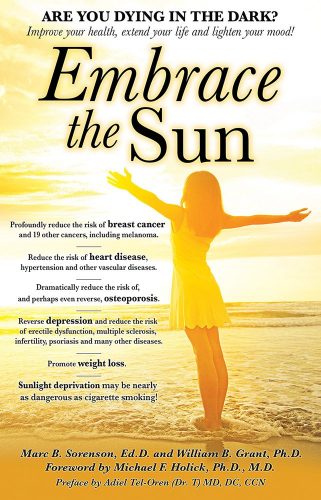
Light exposure for the gut, by Marc Sorenson, EdD L
Light exposure for the gut seems like a strange concept. And, rest assured we will not discuss shining light directly into the gut to optimize health. However, light exposure, according to new research, may assist in gut homeostasis and may positively alter the gut microbiome.

Some words you should know to better understand light exposure for the gut:
Circadian rhythms: Circadian rhythms are variations in physiology and behavior persisting with a cycle length close to, but not exactly, 24 hours. It is necessary to synchronize the rhythms on a regular basis to maintain them. And, such synchronization is usually achieved through regular exposure to light and darkness.
Entrainment: Entrainment occurs when rhythmic physiological or behavioral events are matched to an external environmental factor. So it is ultimately the interaction between circadian rhythms and the environment, especially sunlight or darkness.
Homeostasis: The maintenance of metabolic equilibrium and balance within an animal by a tendency to compensate for disrupting changes. Thus, homeostasis is vital for good health. And conversely, a lack of homeostasis in the gut is a disease state.
Microbiome, or microbiota: A collection of microorganisms living in or on the human body. For the purposes of this discussion, we are interested in those microorganisms, such as bacteria, inhabiting the gut.
UVB: Ultraviolet B light, a part of the solar spectrum, which is also used in experiments by way of sun lamps.
Circadian rhythms: Circadian rhythms are variations in physiology and behavior persisting with a cycle length close to, but not exactly, 24 hours. It is necessary to synchronize the rhythms on a regular basis to maintain them. And, such synchronization is usually achieved through regular exposure to light and darkness.
Entrainment: Entrainment occurs when rhythmic physiological or behavioral events are matched to an external environmental factor. So it is ultimately the interaction between circadian rhythms and the environment, especially sunlight or darkness.
Homeostasis: The maintenance of metabolic equilibrium and balance within an animal by a tendency to compensate for disrupting changes. Thus, homeostasis is vital for good health. And conversely, a lack of homeostasis in the gut is a disease state.
Microbiome, or microbiota: A collection of microorganisms living in or on the human body. For the purposes of this discussion, we are interested in those microorganisms, such as bacteria, inhabiting the gut.
UVB: Ultraviolet B light, a part of the solar spectrum, which is also used in experiments by way of sun lamps.
First of all, let’s discuss the effect of light exposure on gut homeostasis.
There are specialized cells in the body called ILC3s, which are major regulators of inflammation, infection, microbiota composition and metabolism in the gut.
These cells do not function well if they are not synchronized to the biological clock (or circadian rhythm). So, the most effective way to assure that these cells are working is through external light exposure, particularly sunlight. Light signals are the major entraining cues of ILC3s.
In fact, as a result of the removal of circadian regulators in intestines, the researchers showed that many problems occur. Without regulators, light exposure can’t do its job, and therefore the circadian rhythms of the gut would be extinguished. Why? Because ILC3s could not connect to those regulators in the gut. Thus, this caused disrupted homeostasis, impaired epithelium, a deregulated microbiome, increased infection and disrupted lipid metabolism. The researchers stated that “Our work reveals a circadian circuitry that translates environmental light cues into enteric [intestinal] ILC3s, shaping intestinal health, metabolism and organismal homeostasis.” So the bottom line is, for gut health, get your sun exposure daily!
[intestinal]
Secondly, another investigation provides more information regarding light exposure and the gut microbiome.
Light exposure, vitamin D and microbiome makeup are all associated with inflammatory conditions like multiple sclerosis and inflammatory bowel disease. Therefore, scientists hypothesized that a causal chain links the three. So to test the hypothesis, they used female volunteers in a scientific experiment. In addition to three one-minute sessions of full-body UVB exposures, the volunteers had their blood vitamin D levels tested. Furthermore, before and after treatment, stool samples were taken for analysis of volunteers’ gut microbiomes.
The results regarding UVB light exposure and gut microbiome.
As a result of this minuscule UVB light exposure, good bacteria increased in the microbiome, as did vitamin D. Another fact mentioned in the paper was that studies in rodents indicated UVB increased good bacteria while decreasing harmful bacteria. So does this prove vitamin D could be responsible for lessening risk of multiple sclerosis (MS) and inflammatory bowel disease? No. It is especially relevant that many studies on vitamin D supplementation and MS show no effect. The one consistent outcome of the studies is that sun exposure always lessens the risk of MS. Sun exposure produces the marvelous hormone, vitamin D, but it also produces serotonin, endorphin, nitric oxide, BDNF and dopamine. In addition, there are many more photoproducts produced by sun exposure, which have not been fully studied for health benefits.
When possible, use sun exposure or other UVB light exposure to produce your vitamin D.
Therefore, vitamin D levels are, in many cases, surrogate measurements for sun exposure. The health benefits attributed to vitamin D may be due to other factors also being produced by sun exposure. The sun should be used holistically when possible. Using only one photoproduct of sun exposure seems like a mistake. Thus, it is much like extracting a single plant vitamin. That vitamin doesn’t have the health benefits of the entire plant, because it lacks fiber and other nutrients. Therefore, the closest thing to holistic sun is the use of a sunlamp or a sunbed. For more information, visit the sunlight Institute website.
In conclusion, take care of your gut and your health through non-burning, regular sun exposure.

For more information on sun exposure and MS, read the book, Embrace the Sun. Read more on circadian rhythms on http://sunlightinstitute.org/
 Vitamin D is essential in Canada (and Ely). By Marc Sorenson, EdD.
Vitamin D is essential in Canada (and Ely). By Marc Sorenson, EdD.
I just received an excellent press release from my friend Perry Holman, who is touting the Canadian Vitamin D Day. Perry is the Executive Director of the Vitamin D Society. The Society is alarmed about the lack of sunlight and vitamin D production during the long Canadian winter. The points made in the press release, however, are also relevant for all areas of the U.S. that have long, cold winters. This would include Ely, Nevada, my high-school hangout. Therefore, this blog contains a couple of editorial comments regarding Ely and other points in the U.S. [Ely, Minnesota would certainly need this advice too.]
The current lack of vitamin D is due to of the position of the sun in the winter sky. All of the UVB light that stimulates vitamin D production (and many other essential photoproducts) is filtered out when the sun drops too close to the southern horizon.
Here are a few of the salient points made in the release:
- Vitamin D levels plummet this time of year, since the sun can no longer make vitamin D. [This is also true of Ely, NV, where most vitamin D production ceases on about October 1. It starts up again about March 1.]
- 93% of Canadians are vitamin D deficient. [For Ely, the number is probably closer to 50%, but for the Northern states in the U.S., the number is probably closer to 80%.
- This deficiency leads to 23,000 premature deaths yearly in Canada. See this link: https://www.ncbi.nlm.nih.gov/pmc/articles/PMC5129897/pdf/kder-08-01-1248324.pdf
- There are two primary sources of vitamin D Canadians should consider during the winter – artificial UVB exposure and vitamin D3 supplements.
- Artificial UVB exposure can be a surrogate for summer sunshine and is obtained from most sunbeds or through special UVB lamps designed for home use.
- A recent Canadian study found that regular use of sunbeds with UVB similar to outdoor summer sun significantly raised participants’ vitamin D levels to the optimal range. See this link: https://www.ncbi.nlm.nih.gov/pmc/articles/PMC5821157/
- Perry Holman states: “The current health policy limiting sun exposure may be causing more deaths and disease than its preventing. Vitamin D levels have been dropping and more people are becoming vitamin D deficient in Canada. We need a change in direction to encourage people to get moderate non-burning sun exposure to prevent vitamin D deficiency and reduce the risk of serious diseases.” [My comment here is that the research in my book shows the following: for every single death caused by diseases associated with sun exposure, there are approximately 328 deaths caused by diseases associated with sun deprivation.]
Whether you live in Canada, Ely, Nevada, or anywhere else where you either avoid the sun or have no availability of vitamin D-producing sunlight during the colder seasons, you should read this press release. http://www.vitamindsociety.org/press_release.php?id=59
Happy sunning, and as another of my Canadian friends says, “Have a D-lightful day!” And, read my new book, Embrace the Sun, available at Amazon: https://www.amazon.com/Embrace-Sun-Marc-B-Sorenson/dp/069207600X/ref=sr_1_1?ie=UTF8&qid=1540903899&sr=8-1&keywords=embrace+the+sun+sorenson
Multiple sclerosis is a sunlight-deficiency disease. Another reason to embrace the sun. By Marc Sorenson, EdD
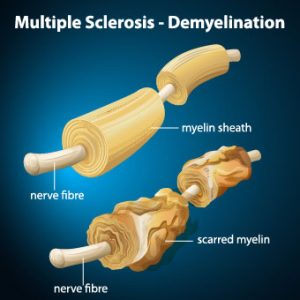 First of all, multiple sclerosis is a terrible autoimmune disease in which immune cells attack myelin, the protective nerve cover.[1], [2] Hence, this process, known as demyelination, leaves the nerves bare and susceptible to “short circuiting.” This results in a debilitating disease which is often characterized by severe neural and muscular impairments. It may also result in sensory losses, bladder dysfunction, pain and visual problems due to nerve damage.
First of all, multiple sclerosis is a terrible autoimmune disease in which immune cells attack myelin, the protective nerve cover.[1], [2] Hence, this process, known as demyelination, leaves the nerves bare and susceptible to “short circuiting.” This results in a debilitating disease which is often characterized by severe neural and muscular impairments. It may also result in sensory losses, bladder dysfunction, pain and visual problems due to nerve damage.
MS is a big problem!
And recent findings, from National MS Society, estimate 1 million people in the United States have multiple sclerosis. Furthermore, this is more double the last reported number, and the first national research on multiple sclerosis prevalence since 1975. Consequently, it is estimated that about 200 new cases are diagnosed each week in the United States.[3]
Multiple sclerosis and sun exposure: What does new research say?
While no one disputes the horror of an increasing MS rate, a new study reiterates the vital need for sun exposure to prevent MS. Also, we are not surprised about the latest research. Why? Because the new study is simply a reiteration of myriad research papers and opinions showing that more sunlight reduces the risk.
In this research, 151 MS patients defined their previous lifetime sun exposure in the different seasons by questionnaire. In addition, they were compared to 235 non-patients who answered identical questionnaires.[1] As a result, those living in high-UVB areas experienced a 45% lower risk of multiple sclerosis. Living in those areas at ages 5 to 15 years also was associated with a reduced risk of 51-52%. UVB, of course, is a spectrum of light that emanates from the sun and causes tanning. In addition, it is used in sunbeds and sun lamps.
The conclusion regarding MS and sunlight.
In conclusion to their research, the authors stated, “Living in high ambient UVB areas during childhood and the years leading up to MS onset was associated with a lower MS risk. High summer sun exposure in high ambient UVB areas was also associated with a reduced risk.”
While this research is impressive, there is a plethora of additional science. Most noteworthy are the studies that follow. And, all show the association of sun exposure to lowered risk of MS.
Multiple sclerosis and the Davenport study
Probably, the most important early study was from 1922 by Dr. Charles Davenport. He wrote a paper entitled, “Multiple Sclerosis from the standpoint of geographic distribution and race.”[2] He analyzed the multiple sclerosis rates of military draftees and compared it to their states of origin. As a result, he showed that the highest rates were found in men who grew up in Michigan, Wisconsin, and the extreme northwest. These areas, of course, have very low sun availability. There were only a few cases of MS among those who grew up in southern states, where sun availability is abundant. In addition, Dr. Davenport also noted that draftees from urban areas, and where sun availability is low, had 50% higher MS rates than those who came from rural areas. Similar studies confirm that relationship. [3],[4] In 1979, assessments of the MS rates of USA military personnel Produced nearly identical results.[5]
Reducing relapse of multiple sclerosis through sunlight and/or vitamin D.
Mowry and colleagues, in correlating serum vitamin D to the rate of disease relapse, have reported the following: For every increase in serum levels of 10 ng/ml [25 nmol/L], there is a 34% decrease in the risk of relapse in young people.[6] Especially relevant, however, is that 90% of serum levels is derived from sun exposure. And, we also know that sun exposure has protective effects on MS beyond vitamin D.[7] Also, in the aforementioned research on vitamin D, high levels may really be surrogate measures for sun exposure. Sunlight and vitamin D are not the same.
More hours of sun equal lower risk of multiple sclerosis.
Most noteworthy, among people living in geographical locations, where there are 3,000 hours of available sun yearly, multiple sclerosis rates are quite low. [8] The same relationship exists when latitudes are correlated with rates of MS: And, The risk of MS in far northern areas is more than 100 times greater than it is in equatorial areas, where sunlight is intense, and the rate of MS approaches zero.[9], [10]
Therefore, for all who would like to prevent MS or reduce its exacerbation, soak up some regular, non-burning, safe sunlight. In conclusion, this is another of the wonderful benefits of our magnificent sun. It seems like a good time to indulge before the winter comes.
Finally, for more information on multiple sclerosis, read my new book, Embrace the Sun, available at Amazon.
References and footnotes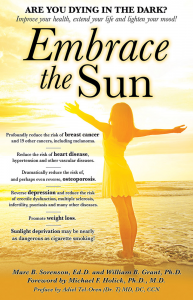
[1] Helen Tremlett, PhD, Feng Zhu, MSc, Alberto Ascherio, MD, DrPH, and Kassandra L. Munger, ScD.
[2] Davenport, C. Multiple Sclerosis from the standpoint of geographic distribution and race. Arch Neurol Psychiatry 1922;8:
[3] Acheson ED, Bachrach CA, Wright FM. Some comments on the relationship of the distribution of multiple sclerosis to altitude, solar radiation and other variables. Acta Psychiat (Scand) 1960;35 (suppl 147):132-47.51-58
[4] Norman JE Jr, Kurtzke JF, Beebe GW. Epidemiology of multiple sclerosis in USA veterans: 2. Latitude, climate, and risk of multiple sclerosis. J Chron Dis 1983;36:551-59
[5] Kurtzke JF, Beebe GW, Norman JE Jr. Epidemiology of multiple sclerosis in USA veterans: 1. Race, sex, and geographic distribution. Neurology 1979;29:1228-35.
[6] Mowry EM, Krupp LB, Milazzo M, Chabas D, Strober JB, Belman AL, McDonald JC, Oksenberg JR, Bacchetti P, Waubant E. Vitamin D status is associated with relapse rate in pediatric-onset MS. Annals of Neurology 2010;10.1002.
[7] Pantazou V, Schluep M, Du Pasquier R. Environmental factors in multiple sclerosis. Presse Med. 2015 ;44(4 Pt 2):e113-20.
[8] Goldberg, P. Multiple sclerosis: vitamin D and calcium as environmental determinants of prevalence (a viewpoint). Part I: sun, dietary factors and epidemiology. Int J Environ Studies 1974;6:19–27.
[9] Alter M, Yamoor M, Harshe M. Multiple sclerosis and nutrition. Arch Neurol l974;31:267-72.
[10] Kurtkze, J. Geography in multiple sclerosis. J Neurol 1977;215:1-26.
[1] Racke, M. Immunopathogenesis of multiple sclerosis. Ann Indian Acad Neurol. 2009 Oct–Dec; 12(4): 215–220.
[2] Markovic-Plese S, McFarland HF. Immunopathogenesis of the multiple sclerosis lesion. Curr Neurol Neurosci Rep 2001;1:257-62
[3] https://www.healthline.com/health/multiple-sclerosis/facts-statistics-infographic#2
 UVB is a spectrum of sunlight with many effects. These include the suppression of inflammation in the skin. It has been used to very successfully treat skin diseases such as psoriasis and eczema.
UVB is a spectrum of sunlight with many effects. These include the suppression of inflammation in the skin. It has been used to very successfully treat skin diseases such as psoriasis and eczema.
Since inflammation is necessary to produce the condition of atherosclerosis (plugging of the arteries). It would be interesting to know whether UVB might also have the same anti-inflammatory effects in the arteries. If so, the effect could inhibit or eliminate atherosclerosis, and thus provide an entirely new treatment for heart disease. It would also protect against vascular events such as stroke and intermittent claudication.
The idea that UVB could prevent atherosclerosis by reducing inflammation in arteries was recently studied by Japanese researchers.[i] Using a mouse model, they demonstrated that UVB light irradiation, applied once a week for 14 weeks, leads to an increase in the action of T-regulatory cells, thereby inhibiting inflammation. In addition, exposure reduced the production of another type of T-cell which is pro-inflammatory and thereby pro-atherogenic (leading to the production of atherosclerosis). These two effects of UVB light reduce the development and progression of atherosclerosis.
Stated differently, the research shows that sun exposure is a critically-important therapy to reduce and prevent diseases of the heart and blood vessels. Protect your heart by being sure to obtain sufficient non-burning sunlight from sun exposure or other sources such as sun lamps. It is also important to note that neither skin cancer nor skin inflammation were observed following UVB exposure in this breakthrough study, which again emphasizes the importance of sun exposure for human health.
If these findings are true, then we would expect that there would be fewer cardiovascular events such as heart attacks and strokes during times of less sun exposure. Accordingly, Research has demonstrated that those below the median level of serum vitamin D suffer 57% more heart attacks than those whose levels were above the median[i] (low vitamin D levels are a surrogate for sun exposure). They also noted that the greatest number of heart attacks occurred in winter and early spring. These seasons, of course, are the times of lowest sun exposure. And, according to what we have learned, they are also the times of greatest inflammation.
Let there be light, and safely apply it to your skin. Be sure not to burn.
[i] Scragg R, Jackson R, Holdaway IM, Lim T, Beaglehole R. Myocardial infarction is inversely associated with plasma 25-hydroxyvitamin D3 levels: a community-based study. Int J Epidemiol 1990;19:559-63.
[i] Sasaki N, Yamashita T, Kasahara K, Fukunaga A, Yamaguchi T, et al. UVB Exposure Prevents Atherosclerosis by Regulating Immunoinflammatory Responses. Arterioscler Thromb Vasc Biol. 2016;36:00-00
Sun Exposure and health by Marc Sorenson, EdD…
A very interesting study has been completed in a remote area of South America.
An indigenous tribe from the remote Bolivian Amazon jungle, known as the Tsimane, has been found to have the world’s healthiest arteries.[1] People there survive on a diet low in saturated fats and high in non-processed foods. One of the researchers stated that “Our study shows that the Tsimane indigenous South Americans have the lowest prevalence of coronary atherosclerosis of any population yet studied.”
Here are some of the lifestyle habits and facts regarding the Tsimane.
- The diet is fiber rich.
- The diet is approximately 75% non-processed carbohydrates. Isn’t that supposed to make us fat?
- The diet includes rice, plantain (a type of banana), corn, nuts, and a very small amount of animal meat.
- Smoking is almost non-existent.
- Only three per cent of the people had moderate to high heart disease risk; two-thirds of them over 75 years of age had virtually no risk. The article states that only 14% of Americans had no risk, and that half had a moderate or high risk—about 5 times higher than the Tsimane.
- Men spend six to seven hours of their day being physically active, whereas women spend four to six hours. This, of course, means plenty of sun exposure.
During most of my professional career, I have advised people to live on this type of diet, but without the meat or any other animal product. In addition we helped them to exercise several hours daily outside. During that time, my wife and I have observed that people have recovered from diabetes, heart disease, arthritis and other maladies. That is no surprise, considering this new research and many other studies. Vitamin D and nitric oxide, both photoproducts, are exceptionally important to human health, but when it comes to heart disease, nitric oxide is probably the operative photoproduct. Here is a quote from Dr. Richard Weller, a common-sense dermatologist and great researcher:
“Sunlight may have beneficial cardiovascular effects, independently of Vitamin D production. Vitamin D could in these circumstances act as a marker for sunlight exposure and its postulated beneficial effects.” “These recent human data show the physiological relevance of photorelaxation. High blood pressure is the leading cause of disability adjusted life years lost worldwide and as a risk factor underlies 18% of all deaths.” The study noted: “The action spectrum of nitrite release shows that ultraviolet B is also involved in nitrite reduction to Nitric Oxide, and thus sunlight may be more effective than a pure UVA source.” The study concluded: “the prevalence of cardiovascular and cerebrovascular deaths is around 100 times higher than those from skin cancer. Interventions leading to small changes in the incidence of cardiovascular disease are thus of greater benefit to the health of the public even than large changes in skin cancer incidence.”[2]
The Tsimane, therefore, are living (unknowingly) an almost perfect lifestyle for optimal health. To stay well, it is imperative that we do the same, although we don’t need quite that much sun exposure. Remember to build up a tan and be safe in the sun.
[1] http://www.mirror.co.uk/science/proof-modern-life-really-kill-10047382
[2] Weller R. The health benefits of UV radiation exposure through vitamin D production or non-vitamin D pathways. Blood pressure and cardiovascular disease. Photochem. Photobiol. Sci. 2016, DOI: 10.1039/C6PP00336B.
By Marc Sorenson, EdD, Sunlight Institute, for sensible tanning bed use
The online magazine, Life Science Daily, just posted an article regarding the health benefits of UV light from tanning beds. Surprisingly, they were quoting from research published in the British Journal of Dermatology. I say “surprising,” because so many dermatologists and dermatological organizations are vehemently opposed to a single ray of sunlight touching the skin. And heaven forbid someone should use a tanning bed.
Three times weekly, adult subjects were exposed to a tanning bed that emitted 95% UVA rays and 5% UVB rays, which is approximately the amount of UVA and UVB that midday summer sunlight emits. Each exposure lasted six minutes. Here are some of the salient points reported in the article:
- Any damage caused by the light exposure was repaired by the skin.
- One of the positive benefits of the light was the production of nitric oxide, which improves blood flow and reduces blood pressure.
- Another positive benefit was the productions of beta-endorphins, which reduce depression.
- A third benefit, of course, is the production of vitamin D, necessary for growth and bone strength, as well as asthma prevention.
Here is one of the important quotes from the article, from Dr. Michael Holick: “What this study shows is that you can get a reasonable amount of sunlight that would make enough vitamin D in your skin living in the U.K. Yes, the DNA is somewhat damaged, but because the body has adapted to its environment, it has the ability to repair it.” Dr. Holick also suggested that people become educated about the wide range of health benefits from modest sun exposure, which is superior to taking vitamin D supplements.
Step by step, the truth is overcoming the powers of darkness! Seek the sun, and let a tanning bed enhance your health in the winter.
Click here to read the article. https://lifesciencedaily.com/stories/19743-study-shows-health-benefits-non-burning-exposure-uv-light/
UVB exposure benefits by Marc Sorenson, EdD. Sunlight Institute…
UVB is a spectrum of sunlight that is responsible for stimulation of vitamin D production in the skin. It also has many other effects, including the suppression of inflammation in the skin, and thus has been used to very successfully treat skin diseases such as psoriasis and eczema.[1] [2] [3] [4]
Since inflammation is also necessary to produce the condition of atherosclerosis (arterial plugging or occlusion) in arteries, it would be interesting to know whether UVB light might also have the same anti-inflammatory effects in those arteries. If so, the UVB effect could inhibit or eliminate atherosclerosis, and by so doing provide an entirely new treatment for heart disease and other vascular events such as stroke and intermittent claudication.
The idea that UVB could prevent atherosclerosis by reducing inflammation in arteries was recently studied by Japanese researchers.[5] [6] Using a mouse model, they demonstrated that UVB light irradiation, once weekly for 14 weeks, leads to an increase in the action of T-regulatory cells that inhibit inflammation. In addition, UVB exposure also reduced the production of another type of T-cell that is pro-inflammatory, and thereby proatherogenic (leading to the production of atherosclerosis). These two effects of UVB light reduce the development and progression of atherosclerosis. Or stated differently, the research shows that sun exposure is critically-important therapy to reduce and prevent heart and other vascular diseases.
Protect your heart by being sure to obtain sufficient non-burning UVB light from sun exposure or other sources such as the UVB lamps used by the researchers. It is important to note that neither skin cancer nor skin inflammation were observed following UVB exposure.
This is another breakthrough study that emphasizes the necessity of sun exposure for human health.
[1] National Psoriasis Foundation web site Oct. 2005.
[2] Yelverton CB, Kulkarni AS, Balkrishnan R, Feldman SR. Home ultraviolet B phototherapy: a cost-effective option for severe psoriasis. Manag Care Interface 2006;19:33-36, 39.
[3] Situm M, Bulat V, Majcen K, Dzapo A, Jezovita J. Benefits of controlled ultraviolet radiation in the treatment of dermatological diseases. Coll Antropol. 2014 Dec;38(4):1249-53.
[4] Gupta A, Arora TC, Jindal A, Bhadoria AS. Efficacy of narrowband ultraviolet B phototherapy and levels of serum vitamin D3 in psoriasis: A prospective study. Indian Dermatol Online J. 2016 Mar-Apr;7(2):87-92.
[5] Naoto Sasaki, Tomoya Yamashita, Kazuyuki Kasahara, Atsushi Fukunaga, Tomoyuki Yamaguchi, et al. UVB Exposure Prevents Atherosclerosis by Regulating Immunoinflammatory Responses. Arterioscler Thromb Vasc Biol. 2016;36:00-00.
DOI: 10.1161/ATVBAHA.116.308063.)
[6] Hafid Ait-Oufella, Andrew P. Sage. Editorial. The Sunlight. A New Immunomodulatory Approach of Atherosclerosis. (Arterioscler Thromb Vasc Biol. 2017;37:7-9. DOI: 10.1161/ATVBAHA.116.308637.)
By Marc Sorenson, EdD. For sun exposure…
It should be well-known by now, but the relationship between sun exposure and myopia (nearsightedness) is still being studied. And as before, the answer is the same: sun deprivation is associated to a greater myopia risk. The difference in this research was the study population, which was a random sample of participants 65 years and older from Europe.[1] Among the factors that the researchers considered important, were vitamin D blood levels, vitamin D polymorphisms, ultraviolet B radiation (UVB), and years in education. Of these factors, only ultraviolet B radiation (UVB) was associated with reduced odds for myopia, especially if higher UVB exposure occurred during adolescence and early adulthood. This is another research paper that shows sun exposure to be protective against a disease, independent of vitamin D.
The authors of the study made this conclusion: “This study, while not designed to determine cause and effect relationships, suggests that increased ultraviolet B exposure, a marker of sunlight exposure, is associated with reduced myopia.
This is one in a long line of studies that show the relationship of sun exposure to myopia, and it doesn’t take a rocket scientist to determine that myopia is caused by lack of sun exposure. The evidence has been building for years. For example, one of the studies showed that the lowest risk of myopia among 12-year-old students was found among those who reported the highest levels of outdoor activity.[2] Some might surmise that the key ingredient was exercise, but that idea was refuted by the fact that there was no association between indoor activity and myopia. Something besides exercise had to be leading to the lower risk of myopia among children who were actively outdoors; it had to be sun. The lower risk of myopia persisted after adjusting for genetic factors, ethnicity and the amount of near work. This is important, because for many years there was an assumption that long hours of study indoors, staring closely at books (near work) and never focusing on distant objects, led to myopia. This study belied that error.
This same research showed that the prevalence of myopia among Chinese children living in Singapore was 29.1%, whereas Chinese children living in Sydney, Australia, had a prevalence rate of only 3.3%. The children in Sydney spent about 13.8 hours per week outdoors compared to 3.05 hours in Singapore. In other words, the children who spent most or their lives indoors had 9.5 times the risk of developing myopia!
Depriving either adults or children of their time in the sunlight leads to myriad illnesses, only one of which is myopia. When will we learn?
[1] Katie M. Williams, FRCOphth; Graham C. G. Bentham, MA; Ian S. Young, MD; et al Association Between Myopia, Ultraviolet B Radiation Exposure, Serum Vitamin D Concentrations, and Genetic Polymorphisms in Vitamin D Metabolic Pathways in a Multicountry European Study. Published Online: December 1, 2016. doi:10.1001/jamaophthalmol.2016.4752
[2] Rose KA, Morgan IG, J, Kifley A, Huynh S, Smith W, Mitchell P. Outdoor activity reduces the prevalence of myopia in children. Ophthalmology 2008 Aug;115(8):1279-85.
By Marc Sorenson, EdD. Sunlight Institute…
This Blog is meant neither to promote the use of tanning beds nor to discourage such use; rather, it is designed to balance the message. Seldom is anything positive said about tanning beds, although there is research that shows many positive benefits; such research is usually ignored because it does not conform to a preconceived notion. We therefore want to present some of that research to demonstrate that there are other opinions that provide some balance to the messages. You, the reader, can then make up your mind based on the research. Knowing the entire truth about any subject is important prior to making up one’s mind regarding that subject.
Sun exposure and tanning have been vilified by many (but not all) dermatologists. Tanning beds have been demonized to an even greater degree and are called “cancer machines” by many in the medical profession and in the popular press. There are movements afoot to make it illegal for those under the age of 18 to even use them, which is woefully misguided and ill-advised. Every beneficial effect of vitamin D that is produced by sun exposure is also produced by the use of high-quality tanning beds, and endorphins and nitric oxide are also produced, just as with the sun. The following is a list and discussion of tanning-bed benefits.
- Many so-called experts have said that tanning beds do not create higher vitamin D levels, but the research belies that falsehood. In a study that compared 50 subjects who used a tanning bed at least once weekly to 106 control subjects who did not use tanning beds, it was shown that tanning-bed users had 90% higher vitamin D levels than non-users, and they also had significantly higher bone-mineral density, indicative of stronger bones.[1] Parathyroid hormone (PTH) levels were also taken and were 18% lower among the tanners. High PTH levels are often associated with weak bones and low vitamin D levels. The researchers compared dark-skinned people with Caucasians and found that tanning-bed sessions increased vitamin D levels almost identically in both ethnic groups.[2]
I am part of an email list of scientists and researchers who are intensely interested in sun research, and who share articles on sun and vitamin D. I received a most interesting email from Rufus Greenbaum, who lives in the UK and who organizes vitamin D symposiums. He recounted how he had met a man who had used tanning beds twice weekly since 1970, and who had just completed a bone densitometer test, known as a DEXA scan. His doctor stated, “You have the strongest bones that I have ever seen.” That news certainly came as no shock. Conventional tanning beds produce large quantities of vitamin D in short periods of time,[3] and vitamin D is absolutely essential for optimal absorption of calcium in the gut.[4] [5] Without calcium absorption, consuming vast quantities of calcium makes little difference to bone strength; much of the calcium will be flushed down the toilet.
- Tanning beds can cure psoriasis and eczema and are often recommended by dermatologists as a way to overcome these diseases. Some common-sense scientists understand that UV light is nearly 100% effective for many dermatologic conditions, and that tanning beds are very convenient sources of UV for patients who cannot otherwise afford the rigorous travel and time commitments necessary to visit the dermatologist.[6] Their investigation involved an arduous search of PubMed and Google Scholar for papers that reported on tanning beds and their salutary effects on different skin diseases.
The searches showed convincingly that tanning beds were a valid use for psoriasis, but also indicated tanning beds could be useful “as a treatment option for atopic dermatitis [eczema], mycosis fungoides, acne, scleroderma, vitiligo, and pruritus, as well as other UV sensitive dermatoses.”
The conclusion they reached was amazing, considering negative reports that are regularly touted by the press. They stated: “Unsupervised sun exposure is a standard recommendation for some patients to obtain phototherapy. Selected use of commercial tanning beds in the treatment of dermatologic conditions may be another useful and effective treatment for those patients with an inability to access office-based or home-based phototherapy.”[Italics mine]
One of the dermatologists who recommends unsupervised sun exposure as stated above is Dr. Julie Moore of Gottlieb Memorial Hospital. She says that sun is one of the best ways to treat psoriasis, so she recommends that her patients “sit out on the deck and give their affected areas a good sun bath.[7]” Hallelujah! Common sense is beginning to penetrate the dermatology profession, as more dermatologists are climbing on the sun bandwagon each year.
- Whereas a daily 400 IU vitamin D supplement does not maintain healthful levels, tanning bed use increases vitamin D levels by 150% in only seven weeks.
- Tanning-bed use reduces chronic pain.[9] [10] In a study by dermatologists, using persons with fibromyalgia symptoms including pain, those who used UV-producing tanning beds experienced a decrease of .44 points on a scale of pain score when compared to those who did not receive UV light. Feelings of well-being and relaxation were also reported among the tanners.[11]
- Sun lamps are now being recommended for use by pregnant women who will give birth in a winter month. The recommendation is being made to protect the unborn child from osteoporosis during adulthood.[12]
- Research from Sweden demonstrated that women who use tanning beds more than three times yearly, had a reduced risk of endometrial cancer of 40- 50%.[13] The authors surmised that the effects observed were likely due to stimulating higher vitamin D levels in winter.
- Tanning-bed use reduces the risk of clots.[14] In an eleven-year study of the sun-exposure habits venous thrombotic (clotting) events of 40,000 women, it was found that women who sunbathed during the summer, on winter vacations, or when abroad, or used a tanning bed, were at 30% reduced risk of venous thrombotic events compared to those who did not. The authors again speculated that increased vitamin D, which has anticoagulant properties, resulted in these positive results.
- Tanning-bed use is associated to lower breast-cancer risk.[15]
- High quality tanning beds, because they provide UVB to both sides of the body simultaneously, stimulate the production of up to 10,000 IU of vitamin D in less than ten minutes. Ten minutes of tanning bed exposure can be done on a lunch break. That means they are more efficient than summer sun. Of course, those with darker skin will require a longer time to produce the same amount of vitamin D.
- It is likely that all benefits of sun can be provided by tanning beds, including increased resistance to cancer, osteoporosis, heart disease, diabetes, periodontitis, arthritis, infection and other maladies.
- Tanning beds may be used regardless of outside weather.
- Tanning beds may be used during “vitamin D winter.” This is especially important at higher latitudes that lack sufficient UVB from winter sun to stimulate adequate vitamin D production by the skin.
The truth about tanning beds and melanoma
As we have shown, it is impossible to establish sun as the cause of melanoma; yet through chicanery and dishonesty, as established by Dr. Ackerman, we continue to see that the desire for profit produces chicanery, dishonesty and hypocrisy, which leads to the continuing mantra of the anti-sun movement—that melanoma is caused by our friend, the sun. That mantra is ludicrous, and the purveyors of the message are beginning to sound silly. We expect that due to the worry that the sun/melanoma message is ready to crash and burn, these same people are now attacking the tanning industry. One of the claims is that since the advent of tanning beds—in about 1970—melanoma has increased dramatically. While that is true, it has nothing to do with tanning beds. Melanoma was increasing steadily and exponentially long before tanning beds hit the scene and that rate of increase was not influenced by tanning beds. Dr. Diane Godar has produced a graph showing that tanning beds made no difference at all in the increase in melanoma. You will note that the rate of increase in melanoma is exactly the same now as it was since 1940. Dr. Godar’s graph is presented below.
Those who oppose the use of tanning beds can conveniently ignore the rate of increase prior to the first tanning beds to make it appear that the tanning bed is the culprit. This is intellectual dishonesty, and it reminds me of the old saying, “There are lies and damn lies, and then there are statistics.” Twisting or ignoring the facts should be criminal.
Several studies have investigated the relationship of tanning-bed use to melanoma and a review of 22 investigations done from 1979 through 2002 showed that only four indicated tanning beds increased melanoma risk; eighteen showed no association.[16] One that showed an increased melanoma risk was conducted by Dr. Philippe Autier and colleagues in Belgium in 1991.[17] However, in 2002 Dr. Autier conducted another study in which no association between tanning bed use and melanoma was found.[18] This report stated, “No result suggested a dose-response curve, and no association was even present for subjects who reported more than 35 hours of cumulated tanning-bed use at least 19 yrs. before the interview. Our study doesn’t support the possibility that tanning bed use could increase melanoma risk.”
I looked for other studies that might have come to contrary conclusions and found one from 2007.[19] It was a meta-analysis of 19 studies that concluded tanning beds do increase the melanoma risk. However, when Dr. Grant assessed the meta-analysis, he noted that the studies failed to take skin type into consideration.[20] He re-analyzed the data and determined: “These results indicate that when studies largely influenced by inclusion of people with skin phenotype 1 [light-skinned non-tanners] without adjustment for skin phenotype are removed from the meta-analysis, no significant relation is found between tanning bed use and risk of CMM [cutaneous malignant melanoma].”
Several studies between 2003 and 2008 showed mixed results. One showed no significant increase in melanoma with tanning bed use.[21] Another study of five European countries showed that in France, where 20% of the population used tanning beds, their use was associated with a 19% increase in risk of melanoma.[22] In Sweden, where 83% of the population used tanning beds, there was a 38% decrease in melanoma. Overall, the risk of melanoma was reduced by 10% in tanning-bed users, although individuals with fair skin and a high number of moles were at increased risk. Clearly, studies that indict tanning beds, without taking into consideration skin type are flawed, and if they do not also differentiate between tanning and burning, they are doubly flawed.
Remember that excessive ultraviolet light exposure, whether it comes from sun or tanning lamps, causes burning. We have clearly established that burning may correlate to an increased risk of melanoma. Unfortunately, most of the studies that associated tanning beds with increased melanoma did not control for burning. Use of either sun exposure or tanning beds must be done prudently, so it is best to use professional tanning salons with trained personnel who assess skin type and make recommendations for the maximum time clients should tan.
Dr. Grant also reminds us that UVB is the most beneficial wavelength. UVA does have health benefits, including stimulating the production of nitric oxide, but excessive UVA is harmful in that it penetrates more deeply and generates free radicals that can lead to skin aging and DNA damage, as several studies have shown.[23] [24] [25] However, the tan produced by UVA serves as a protection against damage by further UVA. It is important to use tanning beds with outputs that mimic the midday, mid-latitude spring-and-summer UVB portion of total UV—roughly 3.5-5%. European countries limit UVB emitted from tanning beds to 1.5% of total UV radiation[26] [27]—a huge mistake. Tanning beds in the USA emit a much higher percentage of UVB, about 5% on average.[28] Prior to 1983, tanning beds used in Norway and Sweden were rich in UVB and there was no association between tanning-bed use and melanoma. Both the lamps and the acrylic sheet between the lamps and the person affect the UVB/UVA ratio; the acrylic, as it ages, decreases the UVB transmission more than UVA.
Personally, I have no qualms about using tanning beds, but I am not telling you to do the same. Read all the facts and then make up your own mind. Considering the numerous health benefits from high serum vitamin D levels and the production of endorphins, nitric oxide and other photoproducts, the slightly increased chance of rarely-fatal common skin cancer does not concern me.
A very light skin that does not tan, or a skin condition that is sensitive to UV may preclude tanning-bed use by some individuals. Those with freckles and red hair do not generally tan well, and should avoid tanning beds or limit themselves to very short exposures. In addition, it is a good idea to cover the face and genitals as those areas may be excessively sensitive to ultraviolet light. Others who may have adverse effects to tanning bed exposure are organ transplant recipients, those with many nevi (moles) or those taking photosensitive prescription drugs.[29] If you do not know if your drug is photosensitive, ask a pharmacist. Avoid even the least amount of burning.
Finally, it is a good idea to be checked regularly by a dermatologist to assess any changes that may occur to your skin. That advice, however, is even more important for those who do not use tanning beds or get regular sun, since more melanomas occur among those who receive little or no UVB, or in those irregularly exposed. In some cases, tanning beds may help the physical and mental health of people residing in the far north.
In one instance, tanning beds for Canadian military personnel may be essential to survival. The Canadian armed forces most remote outpost is also the northernmost community on Earth, and its purpose is to gather radio signals and other electronic intercepts from Russia and pass them to military analysts in the South.[30] The sun disappears on October 14 and does no reappear until February 28. During that time, temperatures drop to 5+ degrees below zero, and if the wind blow, the chill factor is incredibly low. The facility is build with most of the comforts of home, including gym facilities, and tanning machines that increase vitamin D levels are considered essential to life. We expect that if anyone were to try to take away those machines, it would cause an insurrection. In the previous blog, it was also mentioned that scientists have suggested the use of tanning beds for psoriasis when they were too far away from the dermatologists’ offices for a convenient visit.[31]
Tanning beds and other sources of ultraviolet light can be of great value to human health if they are used safely; the same can be said about the sun.
Are phototherapy sessions in a dermatologist’s office safe?
As we have indicated, dermatologists and their organizations, with certain refreshing exceptions, promote the idea that both tanning beds and natural sun exposure are detrimental to health. Yet, thousands of dermatologists use UVR light to reduce the risk of many skin diseases. They claim that their UVR exposure is totally safe. That is an blatant example of duplicity at its worst. Recently, Dr. Anne Haas, President of the California Dermatology Society, made an egregiously false statement at a regulatory hearing regarding UVR devices, saying that whereas tanning beds were cancer causers, the UVR devices used in dermatologists’ offices had never been shown to cause any cancer problems. Watch this short video to hear her statement:
Her statement, that there is no evidence UV devices in the dermatologist’s office cause cancer, is deceitful. Here is the truth:
- The light used by dermatologists is the same type of light used in tanning beds.[32] [33]
- The use of phototherapy in the dermatologist offices definitely do lead to an increase in skin cancer.[34] And some of that skin cancer was sufficiently noteworthy that the researchers concluded their study with this warning: “A noteworthy number of NMSC were diagnosed in this Mediterranean population of patients exposed to high-dose UV treatment. A thorough risk-benefit evaluation should always be done before UV treatment and patients should be carefully monitored for skin cancer during and after treatment discontinuation.”[35]
- The National Psoriasis Foundation recommends brief, frequent exposures of sunlight as a therapy and report that 80% of those who do it improve or totally clear psoriasis.[36]
- Many honest dermatologists recommend tanning-bed use to their patients to clear psoriasis. Obviously it is effective for that disease, and if phototherapy in the dermatologist’s office causes skin cancer, what seems to be the problem? Both therapies work. Why deny someone with psoriasis the benefits of a lower cost and possibly easier accessibility to treatment?[37]
So why the deception? The answer lies in money. When scientists such as those in the last quoted paper advocate tanning beds for therapy, it could cost the dermatology industry a fortune.
Your will note in the graph below that melanoma incidence has increased nearly in lockstep with the increase in the number of dermatologists. What a business! Is there any doubt why they don’t want the tanning industry absorbing the money made from their lucrative and expensive office treatments? Think about it.
Now you know a few more facts about sunlight, tanning beds, health and the deception of the anti-sun groups. Let it sink in and then make your own decision abut sun or tanning bed exposure. And while you decide, please consider the calculation I’ve made in my new book to be released soon: For every death caused by diseases that associate with sun exposure, there are about 350 deaths associated with sun deprivation. Which way would you like to bet?
[1] Tangpricha V, Turner A, Spina C, Decastro S, Chen TC, Holick MF. Tanning is associated with optimal vitamin D status (serum 25-hydroxyvitamin D concentration) and higher bone mineral density. Am J Clin Nutr 2004;80:1645-49.
[2] Hakim OA, Hart K, McCabe P, Berry J, Francesca R, Rhodes LE, Spyrou N, Alfuraih A, Lanham-New S. VITAMIN D PRODUCTION IN UK CAUCASIAN AND SOUTH ASIAN WOMEN FOLLOWING UVR EXPOSURE. J Steroid Biochem Mol Biol. 2016 Mar 22. pii: S0960-0760(16)30072-3. doi: 10.1016/j.jsbmb.2016.03.025. [Epub ahead of print] Review.
[3] Grant, W. Personal communication with the author, June, 2006
[4] Heaney RP, Dowell MS, Hale CA, Bendich A. Calcium Absorption Varies within the Reference Range for Serum 25-Hydroxyvitamin D. Journal of the American College of Nutrition 2003; 22: 142–146.
[5] Heaney, R. Vitamin D and calcium interactions: functional outcomes. Am J Clin Nutr 2008;88(suppl):541S–4S
[6] Radack KP, Farhangian ME, Anderson KL, Feldman SR. A review of the use of tanning beds as a dermatological treatment. Dermatol Ther (Heidelb). 2015 Mar;5(1):37-51.
[7] Science News, August 6, 2013. Summer sun good for psoriasis sufferers says Gottlieb dermatologist.
[8] Holick, M. Boston University. “Effects Of Vitamin D And Skin’s Physiology Examined.” Science Daily 21 February 2008 <http://www.sciencedaily.com¬ /releases/2008/02/080220161707.htm>.
[9] Kaur M, Feldman SR, Liguori A, Fleischer AB Jr. Indoor tanning relieves pain. Photodermatol Photoimmunol Photomed. 2005 Oct;21(5):278.
[10] Taylor SL, Kaur M, LoSicco K, Willard J, Camacho F, O’Rourke KS, Feldman SR. Pilot study of the effect of ultraviolet light on pain and mood in fibromyalgia syndrome. J Altern Complement Med. 2009 Jan;15(1):15-23.
[11] No authors listed. Tanning Beds Provide Potential Pain Relief for Fibromyalgia Patients. Wake Forest Baptist Medical Center Press release, 2009.
[12] Bukhari, M. Quoted in London Times April 27, 2008.
[13] Epstein E, Lindqvist PG, Geppert B, Olsson H. A population-based cohort study on sun habits and endometrial cancer. Br J Cancer. 2009 Aug 4;101(3):537-40.
[14] Lindqvist PG, Epstein E, Olsson H. Does an active sun exposure habit lower the risk of venous thrombotic events? A D-lightful hypothesis. J Thromb Haemost. 2009 Apr;7(4):605-10.
[15] Yang L, Veierød MB, Löf M, Sandin S, Adami HO, Weiderpass E. Prospective study of UV exposure and cancer incidence among Swedish women. J Intern Med. 2014 Jul;276(1):77-86
[16] International Smart Tan Network 2006. Research shows no connection between tanning and melanoma: Why this is misunderstood.
[17] Autier P1, Joarlette M, Lejeune F, Liénard D, André J, Achten G. Cutaneous malignant melanoma and exposure to sunlamps and sunbeds: a descriptive study in Belgium. Melanoma Res. 1991 Apr-May;1(1):69-74.
[18] Autier P, Tanning bed use and risk of melanoma: results from a large multicentric European study. Poster at the XVIII International Pigment Cell conference held 9-13 September 2002 at Egmond The Netherlands.
[19] International Agency for Research on Cancer Working Group on artificial ultraviolet light (UV) and skin cancer. The association of use of tanning beds with cutaneous malignant melanoma and other skin cancer: a systematic review. Int J Cancer 2007;120:1116-22.
[20] Grant, W. Insufficient evidence exists to link tanning bed use to risk of melanoma for other than those with skin phenotype 1. Sun, Nutrition and Health Research Center ( SUNARC). March 9, 2007. www. SUNARC org.
[21] Clough-Gorr KM1, Titus-Ernstoff L, Perry AE, Spencer SK, Ernstoff MS. Exposure to sunlamps, tanning beds and melanoma risk. Cancer Causes Control. 2008 Sep;19(7):659-69.
[22] Bataille V, Boniol M, De Vries E, Severi G, Brandberg Y, Sasieni P A multicentreepidemiological study on sunbed use and cutaneous melanoma in Europe. Eur J Cancer 2005;41:2141-49.
[23]Garland CF, Garland FC, Gorham ED. Epidemiologic evidence for different roles of ultraviolet A and B radiation in melanoma mortality rates. Ann Epidemiol. 2003;13:395-404.
[24] Moan J, Dahlback A, Setlow RB. Epidemiological support for an hypothesis for melanoma induction indicating a role for UVA radiation. Photochem Photobiol. 1999;70):243-7.
[25] Moan J, Porojnicu AC, Dahlback A, Setlow RB. Addressing the health benefits and risks, involving vitamin D or skin cancer, of increased sun exposure. Proc Natl Acad Sci U S A. 2008;15;105(2):668-73.
[26] Grant, W. Insufficient evidence exists to link tanning bed use to risk of melanoma for other than those with skin phenotype 1. Sun, Nutrition and Health Research Center (SUNARC). March 9, 2007. www. SUNARC org.
[27] Autier P. Perspectives in melanoma prevention: the case of tanning beds. Eur J Cancer 2004;40:2367-76.
[28] Grant W. Insufficient evidence exists to link tanning bed use to risk of melanoma for other than those with skin phenotype 1. Sun, Nutrition and Health Research Center (SUNARC). March 9, 2007. www. SUNARC org.
[29] Grant, WB. Personal communication with author.
[30] Matthew Fisher at CFS Alert: Canada’s “frozen Chosen” at top of the world have been in the dark since Oct 14. National Post February 2, 2013.
[31] Radack KP, Farhangian ME, Anderson KL, Feldman SR. A review of the use of tanning beds as a dermatological treatment. Dermatol Ther (Heidelb). 2015 Mar;5(1):37-51.
[32] Archier E1, Devaux S, Castela E, Gallini A, Aubin F, Le Maître M, Aractingi S, Bachelez H, Cribier B, Joly P, Jullien D, Misery L, Paul C, Ortonne JP, Richard MA. Carcinogenic risks of psoralen UV-A therapy and narrowband UV-B therapy in chronic plaque psoriasis: a systematic literature review. J Eur Acad Dermatol Venereol. 2012 May;26 Suppl 3:22-31.
[33] Radack KP, Farhangian ME, Anderson KL, Feldman SR. A review of the use of tanning beds as a dermatological treatment. Dermatol Ther (Heidelb). 2015 Mar;5(1):37-51.
[34] Egeberg A, Thyssen JP, Gislason GH, Skov L. Skin cancer in patients with psoriasis. J Eur Acad Dermatol Venereol. 2016 Mar 2. doi: 10.1111/jdv.13619. [Epub ahead of print].
[35] Maiorino A, De Simone C, Perino F, Caldarola G, Peris K. Melanoma and non-melanoma skin cancer in psoriatic patients treated with high-dose phototherapy. J Dermatolog Treat. 2016 Jan 28:1-5. [Epub ahead of print].
[36] National Psoriasis Foundation web site Oct. 2005.
[37] Radack KP, Farhangian ME, Anderson KL, Feldman SR. A review of the use of tanning beds as a dermatological treatment. Dermatol Ther (Heidelb). 2015 Mar;5(1):37-51.


